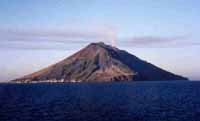Volcano experts monitoring Stromboli off Sicily as lava pours down slopes to sea
Lava continued to pour down Stromboli's slopes and into the Mediterranean near Sicily Wednesday as experts continued to monitor eruption activity on one of Europe's most active volcanoes.

Experts taking helicopter flights over Stromboli and studying data from monitoring devices studding the volcano's slopes said there was no immediate danger to the few hundred residents of the tiny island, 60 kilometers (40 miles) northeast of Sicily.
Stromboli, which on most days belches smoke and flaming lava and rock from its crater, suddenly started spewing a substantial amount of lava into the sea on Tuesday, prompting authorities to warn islanders about the risk of a small tidal wave.
Islanders were told to evacuate homes that are below 10 meters (33 feet) above sea level as a precaution.
"The situation is absolutely under control," Civil Protection chief Guido Bertolaso told journalists on the island after an aerial survey Wednesday.
Ferries and hydrofoils which link Stromboli and the six other islands in the Aeolian archipelago were operating, he noted.
In late 2002, Stromboli experienced a rare effusive eruption -- an outpouring of lava without the volcano's characteristic explosive activity, which was its first in 17 years. A few days later, landslides tumbled down an uninhabited slope, crashing into the sea and setting off a tidal wave.
In spring 2003, Stromboli sent hardened lava raining down on some of the settlements nestled in the folds of the island's green slopes. A few chunks crashed into houses, reports AP.
Parts of Italy's south are marked by volcanic activity. Besides Stromboli, Mount Etna in eastern Sicily bubbles back to life every few months. Experts have been worried about Vesuvius, the volcano which devastated ancient Pompeii in 79 A.D. and which now towers above villages ringing its slopes and the metropolis of Naples.
Subscribe to Pravda.Ru Telegram channel, Facebook, RSS!


